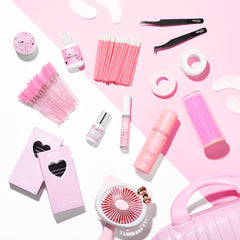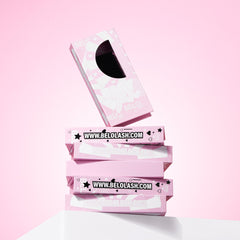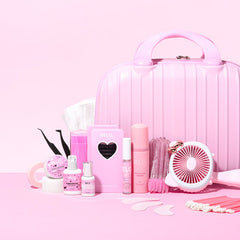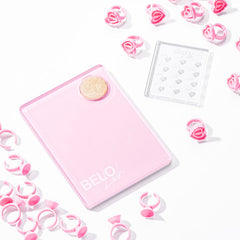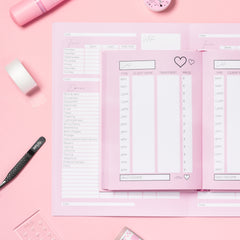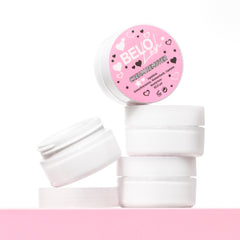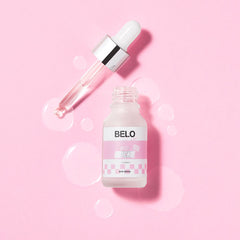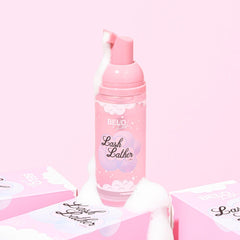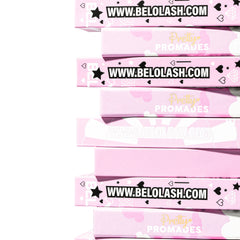Behind every stunning set of eyelash extensions is a little bit of high-quality lash glue.
Literally and figuratively, adhesives are the glue that holds everything together and the foundation for producing gorgeous, long-lasting lashes!
However, as a chemical product, being cautious about the way you apply lash glue is crucial for keeping yourself and your clients safe.
The fumes released by lash glue can cause a number of health concerns when not handled properly. Ample ventilation, using the right products, and educating yourself on lash glue fumes can all help you expand and safeguard your practice as a responsible lash artist.
Here, we’ll delve into the crucial aspects of lash glue fumes, focusing on what they’re made of, their potential health effects, and the many different ways you can minimise your exposure to them while creating durable, show-stopping lashes. Let’s get to it!
What Is Lash Glue Made Of?
Before we discuss the potential health effects of lash glue fumes, let’s run through the chemical ingredients that can cause them in the first place.
The most active ingredient in most lash glues is cyanoacrylate. It makes up around 80-90% of most lash glues made around the world - including Belo’s.
Cyanoacrylate is a non-toxic, quick-curing artificial adhesive used to bond various materials, including skin, metal, and plastic.
Other ingredients you might find in lash glue include polymethyl methacrylate (PMMA), carbon black, silica, formaldehyde, and latex. The use and quantity of each ingredient can vary depending on the product and brand.
All of these chemical ingredients are safe to use externally but should never be consumed, applied to broken skin, or inhaled excessively. It is always important to read the ingredients list of a new lash adhesive you buy so that you know exactly what you’re working with each time.
Lash Glue Fumes: Do’s And Don’ts
Lash glue fumes are a normal, expected result of using lash glue. And like most beauty products, from your shampoo to your mascara, there is a safe and unsafe way to go about using them.
Fortunately, the do’s are easy to practise, and the don'ts are simple to avoid.
Do: Undergo professional training, use the right tools, wear protective gear, and learn about how to deal with eyelash extension glue allergies.
Don’t: Consume lash glue, apply lash glue to broken skin, or apply eyelash extensions without using the right protective gear.
The best way to avoid skin irritations and reactions to fumes from lash glue is to educate yourself on the ins and outs of this crucial adhesive. Knowledge is power, and safety is one of the most important traits an aspiring lash artist can have.
What Are The Potential Health Effects Of Lash Glue Fumes?
If you don’t handle lash glue properly or use it in the wrong environment, inhaling lash glue fumes can cause a number of adverse health effects. The most common ones include:
- Eye irritation
- Respiratory issues
- Headache
- Coughing
- Dizziness
However, most of these effects are marginal and only likely to occur with overexposure (such as working in a factory where the product is manufactured) or allergic reactions.
Practical Tips For Reducing Lash Glue Fumes Exposure
When using lash glue to apply eyelash extensions, caution is key! Not only does working cautiously mean that you’ll achieve a more symmetrical result, but you’ll also prevent lash glue fumes from becoming an irritant in your workspace.
Here are four more Belo tips from our pros:
-
Maintain a well-ventilated workspace
One of the simplest and most effective ways to prevent fumes from lash glue from negatively affecting your clients is to work in a room with plenty of airflow.
Ample ventilation ensures that the fumes are constantly being pulled away from facial cavities and enough oxygen is circulating at your station.
-
Use low-fume adhesives
Some lash adhesives emit less fumes than others. Have a look through our extensive lash glue collection to find adhesive options that work for you and your clients. Knowing how to choose the right lash adhesives for your style and needs is essential for working as a pro lash artist.
-
Wear protective gear
You might not think of lash application as an activity that requires battle gear, but the beautiful craft of cosmetics does call for suitable gear on occasion, and this is one of them!
Wearing gloves and properly sterilising your workstation can protect your skin from getting irritated by fumes from lash glue. If you have a lash glue fume sensitivity or allergy, wearing a disposable mask while you work can help prevent coughing or respiratory issues.
-
Learn about lash glue fume allergies
While uncommon, some people are allergic to the fumes from lash glue. And as a lash technician, you need to know how these allergies work and how to spot them.
When taking on a new client, ask them if they’re aware of any chemical allergies. Performing a simple patch test on their skin can help rule out the potential for any bad reactions. If a client reacts to the fumes by excessively coughing or feeling nauseous, it could be a sign of an allergy.
-
Educate yourself on the fumes from lash glue
The more you know about lash glue fumes, the easier it will be to control and minimise their effects on you and your clients.
You can cultivate a broader understanding of how adhesive fumes work by reading blog posts like this and chatting with your other lash technician friends. It’s a career-long process that will continue to expand and grow as you gain more experience over time.
What Tools Can I Use To Mitigate Lash Glue Fumes?
In addition to the above best practices for avoiding the fumes from lash glue, you can invest in some core tools that help you reduce lash glue fumes.
Some of Belo’s best include:
-
Mini Pink Lash Fan
Belo’s Mini Pink Lash Fan is the cutest way to reduce the effects of fumes during lash treatments. This baby pink-hued mini fan propels lash fumes away while simultaneously helping wet lash glue dry and cure at a faster rate. Plus, it looks adorable!
-
Little Quickie Superbonder
The Little Quickie Superbonder from Belo’s vast lash tool range is a game changer when it comes to retention.
Not only does it reduce the fumes from the adhesive, thus lowering the risk of irritation or sensitivity, but it also strengthens the bond between adhesive and eyelash, leading to a much stronger overall bond.
-
Latex-free lash adhesives
Although latex isn’t always the main cause of irritation from fumes from lash glue, using latex-free lash adhesives can further minimise the potential for reaction and put your clients more at ease.
Belo’s Bulletproof Bond Adhesive, Bulletproof Max Adhesive, and Bestie Bond Adhesive are the best lash glues for sensitive eyes. They are all latex-free and rigorously tested for safer, more comfortable lash applications.
Don’t Let Lash Glue Fumes Get In Your Way
Lash glue fumes are an inevitable aspect of being a lash technician. But while they can cause temporary health issues such as coughing or headaches, there are plenty of ways to reduce their impact on yourself and your clients for a smooth and safe lash application experience.
Understanding how fumes from lash glue develop, what causes them, and which tools and practices to use to avoid them is essential for every professional lash artist.
Protect yourself and your clients from unwanted reactions by working in properly ventilated areas, performing patch tests on new clients, and utilising the right tools. When you do this, you can create showstopping lashes without getting into any sticking (or stinky!) situations!


